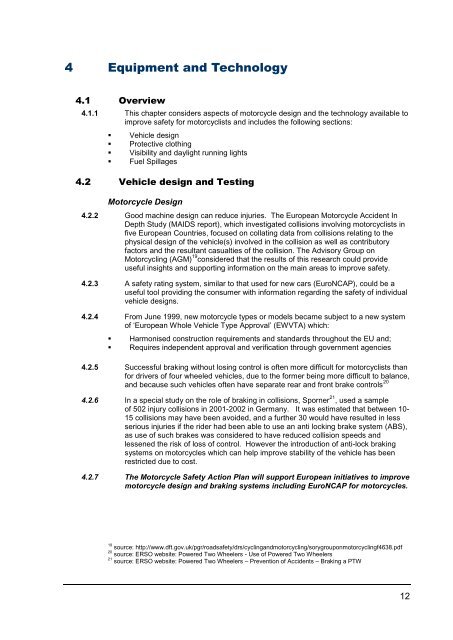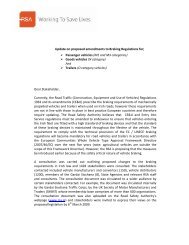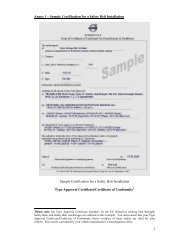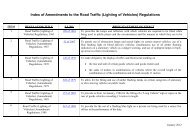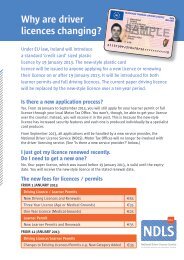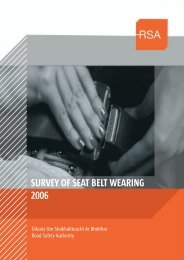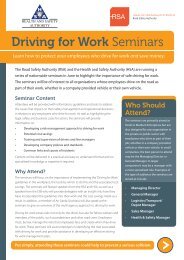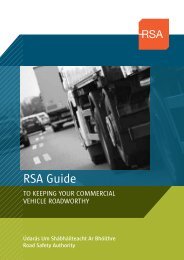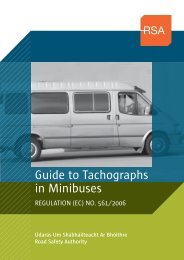National Motorcycle safety action plan - Road Safety Authority
National Motorcycle safety action plan - Road Safety Authority
National Motorcycle safety action plan - Road Safety Authority
You also want an ePaper? Increase the reach of your titles
YUMPU automatically turns print PDFs into web optimized ePapers that Google loves.
4 Equipment and Technology<br />
4.1 Overview<br />
4.1.1 This chapter considers aspects of motorcycle design and the technology available to<br />
improve <strong>safety</strong> for motorcyclists and includes the following sections:<br />
• Vehicle design<br />
• Protective clothing<br />
• Visibility and daylight running lights<br />
• Fuel Spillages<br />
4.2 Vehicle design and Testing<br />
<strong>Motorcycle</strong> Design<br />
4.2.2 Good machine design can reduce injuries. The European <strong>Motorcycle</strong> Accident In<br />
Depth Study (MAIDS report), which investigated collisions involving motorcyclists in<br />
five European Countries, focused on collating data from collisions relating to the<br />
physical design of the vehicle(s) involved in the collision as well as contributory<br />
factors and the resultant casualties of the collision. The Advisory Group on<br />
Motorcycling (AGM) 19 considered that the results of this research could provide<br />
useful insights and supporting information on the main areas to improve <strong>safety</strong>.<br />
4.2.3 A <strong>safety</strong> rating system, similar to that used for new cars (EuroNCAP), could be a<br />
useful tool providing the consumer with information regarding the <strong>safety</strong> of individual<br />
vehicle designs.<br />
4.2.4 From June 1999, new motorcycle types or models became subject to a new system<br />
of ‘European Whole Vehicle Type Approval’ (EWVTA) which:<br />
• Harmonised construction requirements and standards throughout the EU and;<br />
• Requires independent approval and verification through government agencies<br />
4.2.5 Successful braking without losing control is often more difficult for motorcyclists than<br />
for drivers of four wheeled vehicles, due to the former being more difficult to balance,<br />
and because such vehicles often have separate rear and front brake controls 20<br />
4.2.6 In a special study on the role of braking in collisions, Sporner 21 , used a sample<br />
of 502 injury collisions in 2001-2002 in Germany. It was estimated that between 10-<br />
15 collisions may have been avoided, and a further 30 would have resulted in less<br />
serious injuries if the rider had been able to use an anti locking brake system (ABS),<br />
as use of such brakes was considered to have reduced collision speeds and<br />
lessened the risk of loss of control. However the introduction of anti-lock braking<br />
systems on motorcycles which can help improve stability of the vehicle has been<br />
restricted due to cost.<br />
4.2.7 The <strong>Motorcycle</strong> <strong>Safety</strong> Action Plan will support European initiatives to improve<br />
motorcycle design and braking systems including EuroNCAP for motorcycles.<br />
19 source: http://www.dft.gov.uk/pgr/road<strong>safety</strong>/drs/cyclingandmotorcycling/sorygrouponmotorcyclingf4638.pdf<br />
20 source: ERSO website: Powered Two Wheelers - Use of Powered Two Wheelers<br />
21 source: ERSO website: Powered Two Wheelers – Prevention of Accidents – Braking a PTW<br />
12


